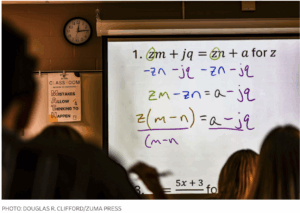
How important is math? The basics in education have always been referred to as the “3 Rs.” Reading, ‘riting, and ‘rithmetic. It doesn’t get more basic than that. Yet, America is failing to achieve these three basic goals.
The Wall Street Journal editorial board tells us that bad news keeps coming from America’s K-12 schools. Last week it was the dismal results from the National Assessment of Educational Progress (NAEP), known as “America’s Report Card.” The report documents the continued decline of students learning basic math.
Since 2013 NAEP math scores have dropped 11 points for eighth-graders and five points for fourth-graders—and the declines are steepest for the lowest-performing students. Twelfth-grade scores have dropped six points. Thirty-nine percent of eighth-graders and 45% of twelfth-graders scored below “basic” proficiency in 2024. That’s less than half of our students who are learning basic math!
Scores were trending up before 2013, so what explains the slide? Researchers at the Center on Reinventing Public Education cite “lowered expectations, inflated grades, and obscured learning gaps.” In recent years, some states have abolished standardized tests or lowered proficiency standards that help keep schools accountable. Only six states still require high school exit exams, compared to 24 in 2013.
Schools also increasingly make it easier for students to get good grades no matter their performance. Especially after Covid, “schools confronted students’ academic struggles and demotivation by making math easier—exactly the opposite reaction to what students needed,” says the report. The truth comes out on standardized tests, and in college and the workplace where those skills are needed.
Students who struggle with math aren’t served well by being relegated to less rigorous “tracks” in early grades with no option to catch up. The report urges states to prepare all students for Algebra I by eighth grade. Some districts have dropped eighth-grade algebra in the name of equity, another example of low expectations harming students.
In other words, the adults who supervise these students are the real problem. In a misguided effort to shelter poor performing students from embarrassment, they have lowered standards and made excuses for poor learning. Perhaps they are also protecting incompetent teachers due to pressure from teachers unions.
Another problem: ideological differences over how to teach math. “Traditionalists” emphasize “math facts and fluency, and support teaching math procedures directly,” says the report. But “advocates for progressive education worry that too much explicit instruction will stifle students’ curiosity and appetite for deeper math understanding, so they dismiss it”—even though this type of instruction is “essential for struggling students.” States ought to re-examine how they’re teaching math, the way many of them have revived phonics instruction for reading in recent years.
The WSJ editors say, “Adding to the woes is a shortage of math teachers. The number of graduates of teacher preparation-programs qualified to teach math declined 36% from 2013 to 2020, according to the report. K-12 test results are a shout from the rooftops that our schools are failing. If our political class wants the U.S. to decline, they’ll keep pretending there’s no problem.”
It is clear we need a shake-up in our education system and abolishing the Department of Education, as President Trump intends to do, seems like a good first step. That will allow states to take charge of the education of their students and get the federal government out of the equation. Eliminating teachers unions would be a great next step. Teachers unions protect poor teachers and promote the failing status quo. School choice, which allows parents to remove their children from failing schools, is the real key to improving our education system. Competition always produces better products at lower costs.

